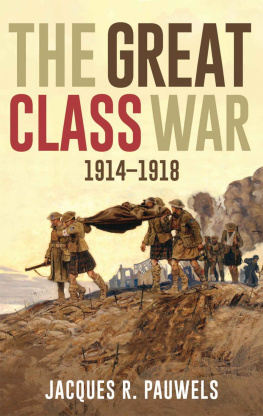The Myth of the Good War
America in the second World War, revised edition
Jacques R. Pauwels
James Lorimer & Company ltd., Publishers Toronto
Copyright 2015, 2002 by Jacques R. Pauwels.
All rights reserved. No part of this book may be reproduced or transmitted in any form or by any means, electronic or mechanical, including photocopying, or by any information storage or retrieval system, without permission in writing from the publisher.
Notice to educators
This book is available for purchase in both print and ebook form. Copies can be purchased from our website at www.lorimer.ca. Copies of individual chapters or portions of the full text in print or digital form are also available for sale at reasonable prices. Contact us for details at rights@lorimer.ca.
The publisher and the author of this work expect that portions of this work will be useful for education, and expect reasonable compensation for this use. This can be readily achieved by arranging to purchase these portions from the publisher. Contrary to the view of university administrators and their legal advisors, it is unlikely that use of a chapter or 10% of this work for educational purposes with no payment to the publisher or author would be found to be fair dealing under the Canadian Copyright Act.
James Lorimer & Company Ltd., Publishers acknowledges the support of the Ontario Arts Council. We acknowledge the financial support of the Government of Canada through the Canada Book Fund for our publishing activities. We acknowledge the support of the Canada Council for the Arts which last year invested $24.3 million in writing and publishing throughout Canada. We acknowledge the Government of Ontario through the Ontario Media Development Corporations Ontario Book Initiative.



Cover photo: National Archives and Records Administration (NARA) in Washington, DC.
Library and Archives Canada Cataloguing in Publication
Pauwels, Jacques R., author
The myth of the good war : America in the Second World War / Jacques R. Pauwels. -- Revised edition.
A revised edition of the 2002 English translation with updated foreword.
Includes bibliographical references and index.
Issued in print and electronic formats.
ISBN 978-1-4594-0872-2 (pbk.).--ISBN 978-1-4594-0873-9 (epub)
1. World War, 1939-1945--United States. I. Title.
D769.P38 2015 940.5373 C2014-908287-8
C2014-908288-6
James Lorimer & Company Ltd., Publishers
317 Adelaide Street West, Suite 1002
Toronto, ON, Canada
M5V 1P9
www.lorimer.ca
Printed and bound in Canada.
Distributed in the United States by
Casemate
2114 Darby Road, 2nd Floor
Havertown, PA 19083
Distributed in the Kingdom by:
Casemate UK
17 Cheap Street
Newbury, RG14 5DD
Contents
Foreword to the new english edition 7
Foreword: Objectives and methodology 11
Chapter 1 Introduction: America and the myth of the Great crusade 19
Chapter 2 The American power elite and Fascism 29
Chapter 3 America and the red peril 42
Chapter 4 The War in Europe and Americas economic interests 53
Chapter 5 Fall 1941: the tide of war turns in Front of Moscow 63
Chapter 6 The United States at war with Japan and Germany 75
Chapter 7 Class warfare on the American home front 86
Chapter 8 A Second Front for Stalin, or a third Front in the air? 95
Chapter 9 Stalins Soviet Union: an unloved but useful partner 107
Chapter 10 The liberation of Italy: a fateful precedent 116
Chapter 11 The long summer of 1944 123
Chapter 12 The successes of the Red Army and the Yalta agreements 132
Chapter 13 Dresden: a signal for Uncle Joe 142
Chapter 14 From Roosevelts soft line to Trumans hard line toward Stalin 169
Chapter 15 An anti-Soviet crusade? 176
Chapter 16 The winding road to the German surrender(s) 187
Chapter 17 America between confidence and concern 193
Chapter 18 Nuclear diplomacy and the onset of the Cold War 201
Chapter 19 A useful new enemy 213
Chapter 20 Corporate collaboration and the so-called de-nazification of Germany (1) 221
Chapter 21 Corporate collaboration and the so-called de-nazification of Germany (2) 237
Chapter 22 The United States, the Soviets, and the post-war fate of Germany 248
Chapter 23 After 1945: From the Good War to Permanent War 267
Endnotes 281
Acknowledgements 301
Select bibliography 303
Foreword to the new English edition
This book was originally written in Dutch, more specifically the variety of Dutch spoken in Belgium and known as Flemish, and it was first published in Belgium in 2000. The English edition was published two years later, in 2002. Since these early years of the twenty-first century, we have come to look at the world through different glasses on account of the tragic events of September 11, 2001, as well as the so-called war on terrorism thus engendered. Nine-eleven was proclaimed to be another Pearl Harbor, and stateside the war on terrorism was and continues to be presented by the authorities and the mainstream media as another good war, like the Second World War.
However, countless people inside and outside the United States have come to question the official rationales for the war on terrorism and are convinced that it is really though not necessarily exclusively about resources such as oil, obviously a commodity of great interest to oil trusts associated with former president George W. Bush, and about profits for the military-industrial complex, exemplified by corporations such as Halliburton, closely associated with former vice-president Dick Cheney. In this context it has become less difficult to accept the notion, put forward in this book, that even in World War II, Americas quintessential good war, the role of the United States was determined far more by the interests of the countrys big corporations and banks than by the idealistic motives conjured up at the time by the authorities and echoed ever since in the media, in schools and universities, in history books, and, of course, in Hollywood productions. World War II, allegedly Americas best war ever (Michael C. C. Adams), is no longer the untouchable historiographical sacred cow it still was a dozen years ago.
Since 2002, also, numerous new books and articles have been produced on relevant topics such as the economic history of Nazi Germany and the American economic penetration of Europe in general and Germany in particular. As an example, we can cite Adam Toozes The Wages of Destruction:The Making and Breaking of the Nazi Economy(2006). Most important for our purposes, naturally, were the new publications dealing with the collaboration of US corporations with Germanys Nazi regime before and during the war. Henry Ashby Turners study of Opel, the German subsidiary of General Motors, entitled General Motors and the Nazis: The Struggle forControl of Opel, Europes Biggest Carmaker (2005), is a good example, and so is Edwin Blacks Nazi Nexus: Americas Corporate Connections to HitlersHolocaust (2009).
Much more is now known than a decade ago about the collaboration of major corporations and banks not only American but also German, French, Swiss, et cetera with fascist movements and regimes in general and with Nazism in particular. (I have examined these connections in a book published in 2013 in French,
Next page
![Jacques R. Pauwels The Myth of the Good War: America in the Second World War, Revised Edition [v.2]](/uploads/posts/book/173448/thumbs/jacques-r-pauwels-the-myth-of-the-good-war.jpg)











